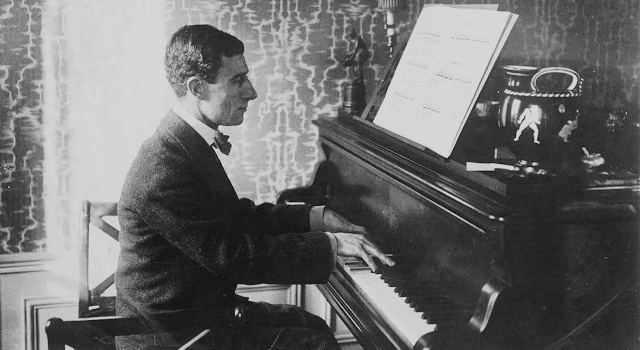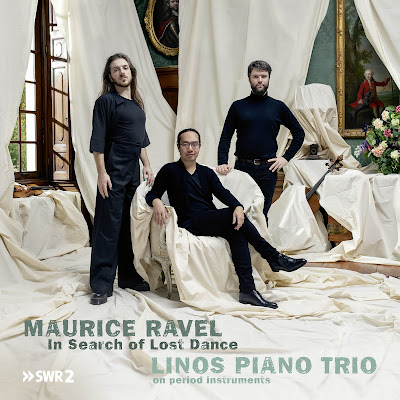In Search of Lost Dance - Ravel: Trio, Pavane pour une infante défunte, Le Tombeau de Couperin; Linos Piano Trio; AVI
Reviewed 18 September 2023
Creating a ravishing sound world from the opening notes, the Linos Piano Trio bring historically informed techniques Ravel's music and make sophisticated magic, transforming our view of this music
The Linos Piano Trio's In Search of Lost Dance on Avi Music (a co-production with SWR2) pairs Ravel's Trio for violin, cello and piano in A minor with the trio's own arrangements of Pavane pour une infante défunte and Le Tombeau de Couperin. The trio, Prach Boondiskulchok (piano), Konrad Elias-Trostmann (violin) and Vladimir Waltham (cello), play on period instruments, an Érard Concert Grand from 1882, a violin by Peter Greiner (2010), after Guarneri del Gesù from 1743, and a cello from Naples ca. 1880. Both string instruments use gut strings with the top one wound.
The use of historically informed performance practice in 20th-century music is becoming more important, Ensembles like Les Siècles demonstrate how icons of modernism such as Stravinsky's The Rite of Spring can be transformed by period instruments and techniques. For this disc, the Linos Trio have gone beyond the pianos that might have been used in recordings from the 1910s and 1920s to the sort of piano that Ravel had at home. As Prach Boondiskulchok explains in the booklet, "Ravel owned and composed on an Érard piano with parallel stringing and a mostly-wooden frame. This is in contrast to the Steinway design of the same period, which he also knew and played, which was cross-strung and had a steel frame to support the higher tension—the design that has become predominant in concert pianos today. The parallel stringing and lower tension of the Érard produced more timbral differences across the range of the piano, and a more transparent sound that is closer to that of string instruments."
With the string instruments on the other hand, we are mainly talking about the fact that players used gut strings, not metal, and these blend wonderfully with the Érard piano. Something the trio found out by experimenting with other set ups. As regards how to play, there are recordings of course, but these raise questions as well as answer them. But what the trio seem to have achieved seems to be based on a real combination of research, experiment and experience. The results are pure aural magic.
 |
| Ravel and his Érard piano in 1925 |
The opening movement of Ravel's Trio is completely ravishing, the three performers bring a lovely fluidity to the music, three different lines sinuously weaving in and out of each other, whilst the change in instrumental timbres and styles, though subtle, makes a great deal of difference. The Érard piano has a softer edge to it, not only does it blend but Boondiskulchok creates real magic. There is often an underlying dance feel to the music, the sense that beneath all this fluidity, there is a firm structure. This continues with the second movement where the music combines transparency with a firm underlying structure and not a little wit. Again, having grown up on this work on a modern piano, one cannot but marvel at the magic Boondiskulchok creates, whilst the two string players follow suit. This is not the type of music where we might expect stylistic touches such as lots of portamento, but there are some and a lovely subtle feel to the sound world. The third movement is beautifully intimate and concentrated, the three players bringing a world of colour into the music. Yet there is also the underlying structure which Boondiskulchok likens to a passacaglia and which the trio render with a sense of intensity that grows then evaporates into sonic magic. The finale opens with more sonic magic, and througout there is a lovely fluidity to the playing, this is far more than an academic exercise, you sense the players acting as a real trio, familiar with each other, following and taking risks. The results are sonic magic but also musical too. Frankly, this becomes essential listening for anyone interested in the work or the chamber music of the period.
Ravel's Pavane pour une infante défunte dates from 1899, well before the other two works on the disc. Maybe it is a pavane, maybe not. Partly the title comes from Ravel liking the sound of the words, but the trio give the music a lovely flowing sense of rhythm. It opens with a gorgeous cello solo over rhythmic elements from the other two, in a performance that has real rhythm yet breathes too. The sound world is more intimate, than Ravel's orchestral version, and the trio really leverage this, they don't try to be anything other than a piano trio.
Ravel wrote his Trio quickly during 1914, whilst from 1914 to 1917 he worked on Le Tombeau de Couperin for piano, in each movement dedicated to a friend who had died during the war and each movement a Baroque dance or other form, a sort of firm gesture against the German domination of music. Ravel later orchestrated four movements to create an orchestral work, but this new arrangement for piano trio goes back to the original six movements, though the Linos Piano Trio's orchestration takes hints both from the orchestral version and the Trio.
The Prélude is all fluidity and flexibility; fleet of tempo it flows like water, yet full of apposite detail. The Fugue, perhaps because Ravel did not orchestrate it, feels less familiar. It is still a fugue, but the trio bring all the subtlety of the approach to Ravel's Trio, whilst the Forlane goes with a delightful swing, the players combining rhythm and clarity to superb and idiomatic effect. It is rhythm that is to the fore in the Rigaudon, but still with that same clarity and no accented note goes unnoticed but none are overdone either, all is balance. The Menuet seems to return us to the sound-world of the Pavane from 15 years earlier, whilst the Toccata is transformed from a bravura keyboard exercise into something dazzling - fast, flexibile and wonderfully delicate.
This is one of those discs that manages to transform our view of the music. The Linos Piano Trio doesn't just play the instruments, dutifully following the academic treatises, they make music together as a real trio, living and breathing together and all three clearly embedded in this new sound world created by the Erard piano and the gut strings. This disc seduces from the word go, but then makes you think about all the other music of the period and what it might sound like, what have we been missing.
Maurice Ravel (1875-1937) - Trio for violin, cello and piano in A minor
Maurice Ravel, arr. Linos Piano Trio - Pavane pour une infante défunte
Maurice Ravel, arr. Linos Piano Trio - Le Tombeau de Couperin
Linos Piano Trio - Prach Boondiskulchok (piano), Konrad Elias-Trostmann (violin) and Vladimir Waltham (cello)
Recorded September 2022, Hans-Rosbaud-Studio, SWR Baden-Baden / Germany
AVI CAVI8553526 1CD [58:52]
Never miss out on future posts by following us
The blog is free, but I'd be delighted if you were to show your appreciation by buying me a coffee.
Elsewhere on this blog
- Polite pastoral: Handel's Tolomeo from Baroque Encounter - opera review
- Mesmerising chamber drama: Dani Howard & Joseph Spence's The Yellow Wallpaper from The Opera Story - opera review
- A glimpse into the lively musical life of 18th-century Dublin: Smock Alley from Carina Drury's ensemble Irlandiani - record review
- Tragédie lyrique given with great sympathy and style: Passion from Véronique Gens with Les Surprises, Louis-Noel Bestion de Camboulas at Bayreuth Baroque Opera Festival - opera review
- From Purcell and Handel to Ignatius Sancho and Duke Ellington: American countertenor Reginald Mobley at Bayreuth Baroque Opera Festival - concert review
- Extravagantly theatrical: Handel's Flavio revived by Bayreuth Baroque in the splendour of the 18th-century theatre - opera review
- Bayreuth Baroque: Operatic arias & overtures by Frederick the Great's court composer, Graun, in the opera house built by the king's sister - opera review
- Prom 64: An evening of compelling drama and wonderful music making, Dinis Sousa conducts Berlioz' Les Troyens - opera review
- Baroque rarity: Élisabeth Jacquet de La Guerre's Céphale et Procris at the Grimeborn Festival - opera review
- The Complete Hums of Pooh and more: Grant Doyle and John Kember's Enchanted Places - record review
- Back to Wonderland: Will Todd's Alice opera returns in an engaging new production at IF Opera -opera review
- Home




.jpg)







No comments:
Post a Comment